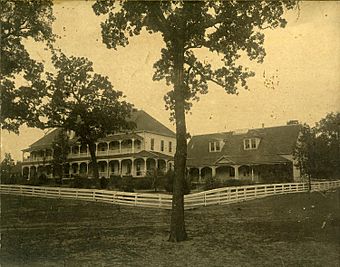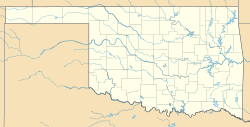Bloomfield Academy (Oklahoma) facts for kids
Quick facts for kids |
|
|
Bloomfield Academy Site
|
|

Bloomfield Academy prior to January 1914 fire, exact date of photograph unknown
|
|
| Nearest city | Achille, Oklahoma |
|---|---|
| Built | 1852 |
| NRHP reference No. | 72001055 |
| Added to NRHP | November 15, 1972 |
Bloomfield Academy was a special school for Chickasaw girls. It was started in 1852 by a minister named John Harpole Carr. The school was in Indian Territory, which is now Oklahoma. It was about 3 miles (4.8 km) southeast of the town of Achille, Oklahoma.
Bloomfield Academy was a boarding school. This means students lived there. It got money from the Methodist Church and the Chickasaw Nation government. Reverend Carr was a Methodist preacher. He had worked in the "Indian Mission Conference" for six years. His first wife passed away in 1847. He remarried in 1852, and his new wife taught music and crafts at the school.
The Academy closed during the American Civil War. A Confederate Army group called the Chickasaw Battalion used the property. After the war, Reverend Carr moved to Texas. The Chickasaw Nation government took over Bloomfield Academy. They reopened it in 1867. Many leaders ran the school over the years. One important leader was Douglas H. Johnston. He was in charge from 1880 to 1895. In 1897, Johnston became the governor of the Chickasaw Nation. He stayed governor until Oklahoma became a state in 1907.
Later, the United States government took responsibility for the Academy. The school stayed in its original location until 1914. Most of the buildings were destroyed by a fire that year. The school then moved to Ardmore, Oklahoma. In 1934, the school became coeducational, meaning both boys and girls could attend. It was also renamed Carter Seminary. In 2004, Carter Seminary moved to a new location near Lake Texoma. It is still operating there today.
Contents
Starting the School (Pre-Civil War)
In 1847, Reverend Carr was asked to build Bloomfield Academy. He chose a spot in 1852 and began construction. He even did some of the building work himself. In June 1852, Carr married his second wife, Angelena Hosmer. She was from Massachusetts.
Getting enough money was always a challenge. One source of money was an annual payment of $1000. This money came from a fund that George Washington had set aside for education. The Chickasaw Nation paid two-thirds of the school's yearly costs. The Methodist Board paid the other one-third. Reverend Carr helped save money because he was a skilled woodworker. He did all the carpentry and cabinet work himself. He also grew corn, wheat, and potatoes on the school land. He even planted two orchards with peaches, plums, and apples. Mrs. Carr taught crafts and music to the girls.
Before the Civil War, Bloomfield taught basic school subjects. It also taught girls how to sew, cook, and do housework. Religious classes focused on learning Christian scriptures. Missionaries hoped this would replace traditional Chickasaw beliefs. When the Civil War began in 1861, Bloomfield and other boarding schools in Indian Territory closed.
During the Civil War
The US Civil War started with fighting at Fort Sumter. Soon after, many students' fathers joined the army. Families called their girls home, and Bloomfield Academy closed in May 1861. The Carr family continued to live at the school. Sadly, Angelina Carr died there in September 1864.
During the war, the school was used as a free private school. The Chickasaw Battalion, a Confederate Army group, planned to use it. But there wasn't enough room for all the soldiers. So, the Carr family was allowed to stay. The soldiers camped outside. They used a small building in the yard as a doctor's office. They also used the sitting room for supplies and the school house as a hospital. Near the end of the war, Reverend Carr learned that his oldest son, Joel Henry, had died from a gunshot wound.
After the Civil War
New Leaders and Changes
Reverend Carr married his third wife, S. J. Johnson, in August 1865. In September 1866, a Methodist meeting was held at Bloomfield. Carr was given a new leadership role. The Carrs left Bloomfield in December 1867. They moved to Paris, Texas. Reverend Carr later worked at a furniture store due to family illnesses. He died on December 29, 1876.
The Chickasaw government reopened Bloomfield Academy that same year. At first, it was a school for both boys and girls. Captain Frederic Young was in charge for the first year. Dr. and Mrs. H. F. Murray then led the school for two years. Professor Robert Cole was superintendent from 1870 to 1875. Other leaders followed, including Professor J. E. Wharton and Robert Boyd.
In 1876, the Chickasaw government created a school for boys. So, Bloomfield Academy became a school for girls only again. Douglas H. Johnston and his wife took over. Mrs. Johnston passed away, and Johnston remarried in 1885. They stayed at Bloomfield until 1895. Then, Johnston was elected governor of the Chickasaw Nation. He helped make education popular among the Chickasaws.
Professor Elihu B. Hinshaw took over after Johnston. He served until 1906. Hinshaw helped Bloomfield get permission to give diplomas to students who finished the school's program. J. R. Hendricks and Annie Ream Addington followed Hinshaw. Annie Addington was in charge until 1914. That year, the main building burned down. Instead of rebuilding, Bloomfield Academy moved to Ardmore, Oklahoma.
New Focus for Learning
After the war, the school's goals changed. The aim was to help students become leaders. They wanted students to be active in both Native American and white communities. They also wanted to help Chickasaws overcome social and economic challenges. Classes on housework were removed. Religious teaching became less important. The academic classes became more like those at a junior college. The school became known as the "Bryn Mawr of the West."
Control of the school passed to the United States government after the Curtis Act of 1898 in 1898.
After moving to Ardmore, Bloomfield continued its work. In 1934, it was renamed Carter Seminary. This new name honored Charles D. Carter. In 1949, Carter Seminary became a co-educational school. It boarded Native American children from all over the United States. In 2002, plans were made to move the Seminary to 160 acres of land near Lake Texoma. This new place was called a Chickasaw Children's Village. The new facility opened in 2004 and is still operating today.
- Bryce, J. Y. Some Notes of Interest Concerning Early Day Operations in Indian Territory by Methodist Church South. Chronicles of Oklahoma 4:3 (September 1926) 233–241.
- Carr, Mrs. S. J. "Bloomfield Academy and its Founder." Chronicles of Oklahoma. 366–379 Vol. 2, No. 4, December 1924.
- Cobb, Amanda J. Listening to Our Grandmothers' Stories: The Bloomfield Academy for Chickasaw Females, 1852–1949 (2000)



